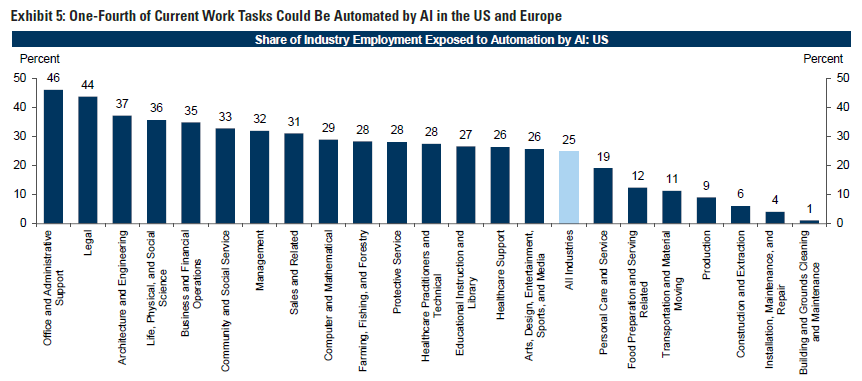Last week, I examined the potential advantages and challenges that AI might introduce to society as a whole. This week, I would like to concentrate on the possible consequences for the labor market, particularly in light of the somewhat alarming note released by Goldman Sachs a few days ago, which suggested that an equivalent of 300 million full-time jobs could be at risk due to generative AI-driven automation.
Firstly, before delving into the specifics of this report, it’s important to recognize that concerns about robots taking jobs from humans are not new. For example, Louis Anslow’s historical retrospective traces such fears back to the 1920s. Drawing on decades of US Census data, Autor & al. argue that “the majority of current employment is found in new job specialties introduced after 1940.” Typically, job displacement in one area leads to job creation elsewhere.
Regarding the Goldman Sachs study, there are several noteworthy points:
- The note refers to job ‘equivalents’ to account for the fact that no job will be completely replaced by AI; rather, bits of various jobs will be affected. Concealed within this statement is a paradigm shift from ‘experience’ and ‘jobs’ to ‘skills’ and ‘activities’. AI alters the manner in which activities are conducted, and these activities should be viewed as ‘building blocks’ of what we currently consider ‘jobs.’;
- Despite this caveat, and as mentioned last week, the AI revolution will mainly impact white-collar jobs, some of which are in industries that presently demand significant training and, consequently, higher salaries due to supply and demand. Coding skills, currently sought after by companies, could experience a decline in demand as a result of increased productivity from AI advancements, without even considering the potential for applications to be designed with little or no code (‘low code‘/’no code‘) in the future. Daniel Susskind (among others) emphasized in his book, ‘A World Without Work: Technology, Automation, and How We Should Respond‘, that activities most susceptible to automation and AI are those that can be codified. ChatGPT and similar technologies have just expanded the realm of possibilities;

- The report clarifies that ‘exposure’ to AI does not automatically imply AI will take over the activity; in many cases, it may complement human activity and enhance productivity. In my opinion, this is the most likely scenario – for instance, in the case of a computer developer, AI could save significant time in designing and verifying code, but it is hard to imagine new software being responsibly released without thorough human review.
Focusing on the positives, where do humans maintain an advantage in the face of machines? I identify four areas where we, as humans, can still benefit:
- Some blue-collar jobs. Since the COVID crisis, the importance of a local blue-collar workforce as a source of strategic independence has become evident. Current geopolitical tensions only strengthen this need – until advances in AI and robotics alter the game once more.
- High intellectual value-added activities that currently cannot be logically explained or codified. This notably includes corporate strategy activities – much to the delight of consulting firms.
- The ‘soft’ skills layer that surrounds the cold, calculating core. Despite some claims to the contrary, I believe we are far from witnessing humanoids exhibit genuine emotions and human qualities like empathy.
- While AI skills are becoming less domain-specific and increasingly general, I remain convinced that humans have an advantage in orchestrating various skills and workforces, akin to a conductor. Will we see a resurgence of generalists following decades of increasing specialization in organizations?
In line with this blog’s philosophy, the aim of this article is neither to downplay nor to amplify the transformations AI might introduce to the labor market. Instead, we seek to comprehend the intricacies of a situation that is bound to remain dynamic for years to come. I firmly believe that the advancements we witness will significantly influence the nature of society and the working world for ourselves and future generations.
“Success in creating AI would be the biggest event in human history. Unfortunately, it might also be the last, unless we learn how to avoid the risks.” (Stephen Hawking)
P.S.: One final thought. Since penning my inaugural article about the perils of ChatGPT last week, a consortium of citizens, Elon Musk among them, has advocated for ‘a pause on AI.’ While this proposal is theoretically laudable, it appears unrealistic, as expert Gilles Babinet (writing in French) points out. The widespread dissemination of this technology, facilitated by its nearly cost-free nature, renders control challenging, unlike other domains such as nuclear weapons mastery. Regrettably, the only viable solution seems to be an arms race, pitting AI against AI to combat the technology’s potential threats.
